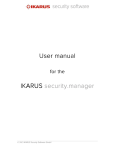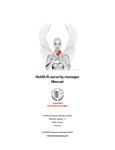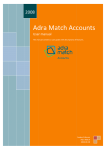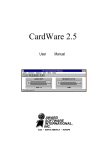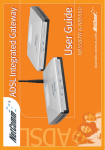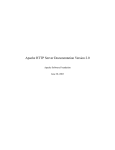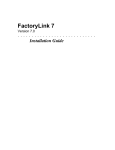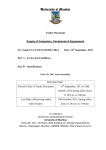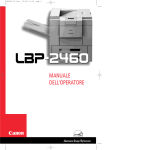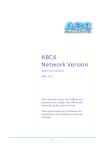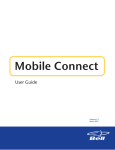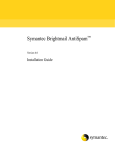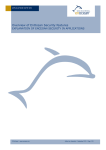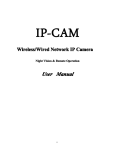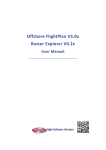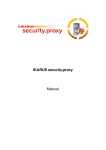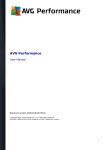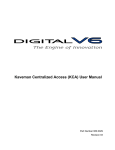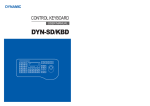Download IKARUS security.manager_Manual_en
Transcript
User manual for the IKARUS security.manager © 2012 IKARUS Security Software GmbH 1 ABOUT IKARUS ................................................................................................................ - 4 - 2 INTRODUCTION ............................................................................................................... - 5 3 THE IKARUS SECURITY.MANAGER SECURITY.MANAGER................................................................................. - 6 3.1 THE IKARUS SECURITY. MANAGER SERVER .......................................................................... - 7 3.2 THE IKARUS SECURITY. MANAGER UI .................................................................................. - 8 4 INSTALLING THE IKARUS SECURITY.MANAGER SECURITY.MANAGER ........................................................... - 9 4.1 INSTALLING THE IKARUS SECURITY. MANAGER SERVER ....................................................... - 10 4.1.1 SYSTEM REQUIREMENTS.......................................................................................................... - 11 4.1.2 WELCOME ............................................................................................................................... - 12 4.1.3 LICENSE AGREEMENT .............................................................................................................. - 13 4.1.4 LDAP SETTINGS ..................................................................................................................... - 14 4.1.5 DEPLOYMENT SETTINGS .......................................................................................................... - 15 4.1.6 USER SETTINGS ...................................................................................................................... - 16 4.1.7 NETWORK SETTINGS ............................................................................................................... - 17 4.1.8 DATABASE SETTINGS .............................................................................................................. - 18 4.1.9 SELECTING THE INSTALLATION FOLDER ................................................................................... - 19 4.1.10 CONFIRM INSTALLATION ........................................................................................................ - 20 4.1.11 INSTALLATION COMPLETE...................................................................................................... - 21 4.2 INSTALLING THE IKARUS SECURITY. MANAGER UI ............................................................... - 22 4.2.1 SYSTEM REQUIREMENTS.......................................................................................................... - 23 4.2.2 WELCOME ............................................................................................................................... - 24 4.2.3 LICENSE AGREEMENT .............................................................................................................. - 25 4.2.4 SELECTING THE INSTALLATION FOLDER ................................................................................... - 26 4.2.5 CONFIRM INSTALLATION .......................................................................................................... - 27 4.2.6 INSTALLATION COMPLETE........................................................................................................ - 28 4.3 U PGRADING A LEGACY IKARUS SECURITY MANAGER X VERSION TO THE NEW IKARUS SECURITY. MANAGER ................................................................................................................. - 29 5 THE IKARUS SECURITY.MANAGER SECURITY.MANAGER UI ...........................................................................- 30 5.1 LOGIN ............................................................................................................................. - 30 5.1.1 SET PASSWORD ...................................................................................................................... - 31 5.1.2 CHANGE MANAGEMENT .......................................................................................................... - 32 5.1.3 SET LICENSE ........................................................................................................................... - 33 5.1.4 LICENSE VIOLATION ................................................................................................................ - 33 5.2 THE U SER INTERFACE....................................................................................................... - 35 5.2.1 DIRECTORY ............................................................................................................................. - 36 5.2.2 PENDING TASKS ...................................................................................................................... - 41 5.2.3 VIRUS LIST .............................................................................................................................. - 44 5.2.4 LOG FILE ................................................................................................................................. - 46 5.2.5 CHANGE LOG .......................................................................................................................... - 47 5.2.6 OVERVIEW PAGE ..................................................................................................................... - 48 5.2.7 PROPERTIES PAGE ................................................................................................................... - 49 5.2.8 GENERAL PAGE ON GROUPS ................................................................................................... - 51 5.2.9 GENERAL PAGE ON CLIENTS .................................................................................................... - 52 © 2012 IKARUS Security Software GmbH Page - 2 - 5.2.10 5.2.11 5.2.12 5.2.13 5.2.14 5.2.15 5.2.16 NOTIFICATION BAR ............................................................................................................... - 54 IKARUS ANTI.VIRUS CONFIGURATIONS ................................................................................. - 55 IKARUS SECURITY.MANAGER SETTINGS ................................................................................ - 67 DIALOG “CLEAN HOST-ENTRIES FROM DATABASE” ................................................................. - 71 ABOUT DIALOG ..................................................................................................................... - 72 THE MENU BAR ..................................................................................................................... - 73 THE TOOLBAR ....................................................................................................................... - 76 - 6 THE SHARED DIRECTORY ..............................................................................................- 77 7 LICENSING INFORMATION INFORMATION .............................................................................................- 78 7.1 REGISTRATION ................................................................................................................. - 78 7.1.1 LAYOUT .................................................................................................................................. - 78 7.2 ACTIVATION KEY.............................................................................................................. - 78 7.2.1 LAYOUT .................................................................................................................................. - 79 8 SOFTWARE DISTRIBUTION DISTRIBUTION ............................................................................................- 80 8.1 INSTALLING THE IKARUS ANTI. VIRUS ................................................................................ - 81 8.2 U NINSTALLING THE IKARUS ANTI. VIRUS ............................................................................ - 83 9 CONFIG FILE ...................................................................................................................- 84 9.1 THE <CONFIG> SECTION .................................................................................................. - 85 9.2 THE <LDAP> SECTION ...................................................................................................... - 86 10 TABLE OF FIGURES ......................................................................................................- 87 - 11 GLOSSARY ....................................................................................................................- 89 - © 2012 IKARUS Security Software GmbH Page - 3 - 1 About IKARUS As one of the first antivirus software providers, IKARUS is both a pioneer and a vibrant, fast-growing company. For more than 25 years, IKARUS software has been a name you can trust to provide outstanding antivirus protection and content security. The development team recruited UNIX and Microsoft specialists as well as former employees from universities and research institutes. Through its numerous cooperation arrangements and special agreements with IT security experts, IKARUS is able to provide up-to-the-minute information and responses in all areas relating to security software. Our products range from simple yet highly effective antivirus protection (IKARUS IKARUS anti.virus) to sophisticated software for networks and gateways (IKARUS IKARUS securiti.virus security.manager, ty.manager IKARUS security.proxy) security.proxy all the way to IKARUS web.security and IKARUS my.mailwall, my.mailwall a high-end managed security product that protects your network from viruses before they strike. © 2012 IKARUS Security Software GmbH Page - 4 - 2 Introduction Thank you for choosing the IKARUS security.manager, security.manager the simple and inspired solution that always provides the computers on your network with the latest virus and spam database updates and IKARUS anti.virus versions. Basically, IKARUS securisecurity.manager distributes the databases and updates from a central point to the computers on your network to save bandwidth, download volume, and, above all, administration time and costs. © 2012 IKARUS Security Software GmbH Page - 5 - 3 The IKARUS security.manager The IKARUS security.manager allows for installing, updating, uninstalling, and configuring the IKARUS anti.virus on your network. The IKARUS security.manager consists of two separate applications: the IKARUS ses ecurity.manager Server and the IKARUS security.manager UI. UI Both can be installed and run on different computers separately from each other. This separation allows you to control and maintain your network protection from anywhere you want, anytime you want. © 2012 IKARUS Security Software GmbH Page - 6 - 3.1 The IKARUS security.manager Server The IKARUS security.manager Server is the core of the IKARUS security.manager. security.manager It is the part that actually does all the distributional and statistical work and also handles the communication between the IKARUS security.manager and the IKARUS anti.virus installed on the computers on your network. The IKARUS security.manager Server runs on a Windows server operating system as a service. All of the settings and information the IKARUS security.manager Server holds are saved in a MSSQL database, which can but does not need to reside on the computer where the IKARUS security.manager Server is installed. The communication between the IKARUS security.manager and the IKARUS anti.virus on your network is established via TCP using 9887 as the default port number. That port can be modified in the Config File of the IKARUS security.manager Server. Server Since the IKARUS security.manager Server needs to perform executional tasks remotely on computers on your network, it needs appropriate rights. Therefore, we highly recommend installing the IKARUS security.manager Server service using a user account with administrative rights for your domain. This will ensure that the IKARUS secusecurity.manager Server is allowed to install and administer the IKARUS anti.virus on computers within the domain on your network. For further information about this topic and the administration of computers outside your domain, please read the Software Distribution chapter. © 2012 IKARUS Security Software GmbH Page - 7 - 3.2 The IKARUS security.manager UI The IKARUS security.manager UI provides the graphical interface to control the IKARUS security.manager Server. Server You can install the IKARUS security.manager UI on any computer you wish to control the IKARUS security.manager Server from. For more information about the layout and different windows of the IKARUS security.manager UI, UI refer to section 5.2. Note: Note You must run the UI as an administrator; otherwise the update of the UI to a later version might fail. © 2012 IKARUS Security Software GmbH Page - 8 - 4 Installing the IKARUS security.manager In this chapter, you will be guided through the installation process of the IKARUS secusecurity.manager. rity.manager The setup is split into two separate installation processes: the IKARUS security.manager Server setup and the IKARUS security.manager UI setup. Both setup processes will automatically check your target system for installed prerequisites needed for the application to run and will optionally install missing software requirements automatically before the actual installation of the IKARUS product is started. Note that a restart of the target computer may be required during the installation of missing prerequisites. In this case, the setup process will automatically continue after a successful restart of the computer. Note: Note To install the Server and the UI you need administrative rights. If the User Access Control feature is enabled, launch setup using the Run as Administrator command. © 2012 IKARUS Security Software GmbH Page - 9 - 4.1 Installing the IKARUS security.manager Server To launch the installation of the IKARUS security.manager Server, Server double-click the Setup-- ISM(server)_xxxx Setup ISM(server)_xxxx file (where xxxx represents the version number). © 2012 IKARUS Security Software GmbH Page - 10 - 4.1.1 System Requirements Hardware requirements: • x86-based PC with 2 GHz or better • 1 GB RAM • Screen resolution: 1024 × 768 or higher • Approx. 500 MB of disk space (depending on the log volume and the download-cache size) • Internet connection Software Requirements: • Windows 2003 Server or later (32-bit/64-bit) • Windows XP or later (32-bit/64-bit) • MSSQL Server (Express) 2005 or later (does not need to be installed on the target machine) • Active directory (Microsoft Windows Domain structure) © 2012 IKARUS Security Software GmbH Page - 11 - 4.1.2 Welcome Click Next to read the license agreement. Figure 4-1 Server Installation – Welcome © 2012 IKARUS Security Software GmbH Page - 12 - 4.1.3 License Agreement The licensing conditions must be accepted to install the IKARUS security.manager Server. Server Figure 4-2 Server Installation – License Agreement © 2012 IKARUS Security Software GmbH Page - 13 - 4.1.4 LDAP Settings If the IKARUS security.manager Server setup is unable to automatically read out and provide the necessary information about your LDAP configuration, you may define the server name and credentials the IKARUS security.manager Server should use for communicating with the LDAP server. Figure 4-3 Server Installation – LDAP Settings © 2012 IKARUS Security Software GmbH Page - 14 - 4.1.5 Deployment Settings To distribute the IKARUS anti.virus on your network, the IKARUS security.manager Server needs a place to store the binaries used for installing the IKARUS virus.utilties. virus.utilties For that purpose, you will need to set up (if you have not done so already) a network share where all clients you want to install the IKARUS anti.virus on have at least read access to. For further information about the IKARUS anti.virus deployment, refer to the Software Distribution and Shared Directory sections. Figure 4-4 Server Installation – Deployment Settings © 2012 IKARUS Security Software GmbH Page - 15 - 4.1.6 User Settings The IKARUS security.manager Server is installed as a service. Services can be installed with the local system accounts or a user account within your domain. Since the IKARUS security.manager Server needs appropriate rights to perform a binary execution remotely, it is highly recommended to install the IKARUS security.manager Server service with a user account which is allowed to administer the domain. Figure 4-5 Server Installation – User Settings © 2012 IKARUS Security Software GmbH Page - 16 - 4.1.7 Network Settings If you have set up a proxy server for your Internet connection, you need to specify the correct settings for your proxy server to allow the IKARUS security.manager Server to access the Internet. The accuracy of the information you provide here is mandatory for an expedient use of the IKARUS security.manager. security.manager No Internet access means that no updates can be retrieved from the IKARUS update servers; thus, your network will be open to possible threats. threats Figure 4-6 Server Installation – Network Settings © 2012 IKARUS Security Software GmbH Page - 17 - 4.1.8 Database Settings The IKARUS security.manager Server needs a MSSQL database to store the settings, configurations, and the client information. The database may reside on the computer where the IKARUS security.manager Server will be installed. If you want to specify a MSSQL database on a different computer, click User defined connection and replace the SERVER=.\ string with SERVER=SERVER_NAME\. (Replace “SERVER_NAME” with the server name of the target computer where the MSSQL database resides.) If you already have at least one MSSQL instance installed, setup will list the installed instances you can choose from. If no MSSQL instances be installed locally, you will be asked if you want to install Microsoft SQL Express 2005 or Microsoft SQL Express 2008. (These programs are free of charge.) If the download process fails, you may want to check the proxy server information you provided in the Network Settings dialog to ensure your Internet connection is working. Figure 4-7 Server Installation – Database Settings © 2012 IKARUS Security Software GmbH Page - 18 - 4.1.9 Selecting Selecting the Installation Ins tallation Folder In this dialog, you can choose the destination folder to install the IKARUS securisecurity.manager Server files to. Figure 4-8 Server Installation – Select Installation Folder © 2012 IKARUS Security Software GmbH Page - 19 - 4.1.10 Confirm Installation This is the final step before the IKARUS security.manager Server files are actually installed. Click Next to start the copy process. Figure 4-9 Server Installation – Confirm Installation © 2012 IKARUS Security Software GmbH Page - 20 - 4.1.11 Installation Complete Congratulations! You successfully installed the IKARUS security.manager Server. Server If a different text is displayed in this dialog, contact the IKARUS support hotline. Figure 4-10 Server Installation – Installation Complete © 2012 IKARUS Security Software GmbH Page - 21 - 4.2 Installing Installing the IKARUS security.manager UI To launch the installation of the IKARUS security.manager UI, UI double-click the SetupSetupISM(UI)_xxxx file (where xxxx represents the version number). © 2012 IKARUS Security Software GmbH Page - 22 - 4.2.1 System Requirements Hardware requirements: • x86-based PC with 2 GHz or better • 1 GB RAM • Screen resolution: 1024 × 768 or higher • Approx. 20 MB of disk space. • LAN connection Software requirements: • Windows 2003 Server or later (32-bit/64-bit) • Windows XP or later (32-bit/64-bit) • .NET framework 4.0 © 2012 IKARUS Security Software GmbH Page - 23 - 4.2.2 Welcome Click Next to read the license agreement. Figure 4-11 UI Installation – Welcome © 2012 IKARUS Security Software GmbH Page - 24 - 4.2.3 License Agreement The licensing conditions must be accepted to install the IKARUS security.manager UI. UI Figure 4-12 UI Installation – License Agreement © 2012 IKARUS Security Software GmbH Page - 25 - 4.2.4 Selecting Selecting the Installation Folder In this dialog, you can choose the destination folder to install the IKARUS securisecurity.manager UI files to. Figure 4-13 UI Installation – Select Installation Folder © 2012 IKARUS Security Software GmbH Page - 26 - 4.2.5 Confirm Installation This is the final step before the IKARUS security.manager UI files are actually installed. Click Next to start the copy process. Figure 4-14 UI Installation – Confirm Installation © 2012 IKARUS Security Software GmbH Page - 27 - 4.2.6 Installation Complete Congratulations! You successfully installed the IKARUS security.manager UI. UI If a different text is displayed in this dialog, contact the IKARUS support hotline. Figure 4-15 UI Installation – Installation Complete © 2012 IKARUS Security Software GmbH Page - 28 - 4.3 Upgrading Upgrading a Legacy IKARUS Security Manager X Version to the New IKARUS securisecur ity.manager A legacy version of IKARUS Security Manager X will automatically upgrade to the new IKARUS security.manager. (This requires to enable silent updates – see section 5.2.12.4.) After the upgrade is complete, the installation path is unchanged but the directory structure contained in will have been rearranged, and binary filenames will have changed. Therefore, you might need to create new firewall rules as appropriate. When the upgrade has been completed successfully, the database will assume the new structure and layout. During the upgrade, a backup of your old database named ISMX_DATABASE_BACKUP.bak will be created in the log folder of your installation. © 2012 IKARUS Security Software GmbH Page - 29 - 5 5.1 The IKARUS security.manager UI Login When launching the IKARUS security.manager UI, UI the first window to be displayed is the Login window (Figure 5-1). You will be asked for credentials and the server to connect to (i.e. the server where the IKARUS security.manager Server is installed). The default TCP port the connections are established with is 9887 for the IKARUS securisecurity.manager Server to IKARUS security.manager UI communication and 9888 for the communication between the IKARUS security.manager Server and the IKARUS anti.virus clients. clients You can change the ports in the Config File of the IKARUS securisecurity.manager Server. Server Figure 5-1 UI – Login © 2012 IKARUS Security Software GmbH Page - 30 - 5.1.1 Set Password At the initial login attempt, you do not need to enter a password since you have not configured it yet. Leave the Password field empty and click the OK button. You will then be prompted to enter a new password for the specified user. Figure 5-2 UI – Set Password © 2012 IKARUS Security Software GmbH Page - 31 - 5.1.2 Change Management If Ask for Request for Change (RfC) ID is enabled in the IKARUS security.manager Server settings (see chapter 5.2.12), you will be asked to enter a request for change ID in the login window (Figure 5-1). If Ask for comment on log-in screen (see chapter 5.2.5) is enabled, you will be asked to enter a comment each time you try to log in. This is useful if you want to track any changes made to settings, and for indicating what you are going to do during that session. Figure 5-3 UI – Change Management © 2012 IKARUS Security Software GmbH Page - 32 - 5.1.3 Set License If you not have chosen a valid license file during the setup of the IKARUS securisecurity.manager Server, Server you will now be prompted again to either choose a license file or complete the registration using an Activation Key. 5.1.4 License Violation If you are not a current IKARUS security.manager X user, you may skip this section; if you are, there are a number of reasons why there are more administered clients on your network than actually allowed. This is a license violation, which is handled in this new version of the IKARUS security.manager. security.manager You will be prompted to remove the excessive number of clients from administration to meet the requirements of the license you are using. License Information Displays the expiration date and how much of your license capacity is used and free. Shows how many clients you need to remove from administration. Moves all clients to the right-hand list. Moves selected clients to the right-hand list. Moves selected clients to the left-hand list. Moves all clients to the left –hand list. Applies all changes. This button is only enabled when you choose an appropriate number of clients. Renew License Opens the registration window, see section 7.1. Lists of all clients that are administrated. Figure 5-4 UI – License Violation © 2012 IKARUS Security Software GmbH Page - 33 - List of all clients that will be removed from administration. You may cancel this process but will not be allowed to login to the IKARUS securisecurity.manager UI until you solve this issue. The clients will still be administered and protected by the IKARUS security.manager Server if you cancel this process. If you need to purchase new licenses or have any questions concerning your license, please feel free to contact our sales team at [email protected]. © 2012 IKARUS Security Software GmbH Page - 34 - 5.2 The User Interface The layout of the IKARUS security.manager UI can be customized. Each window can be docked or undocked and moved anywhere on the screen. The window layout will be stored upon closing the IKARUS security.manager UI. UI Figure 5-5 UI – User Interface © 2012 IKARUS Security Software GmbH Page - 35 - 5.2.1 Directory The Directory (Figure 5-6) is the center of almost all client related operations. It holds the clients of your Active Directory and the clients you manually add (e.g. clients that exist outside your domain or in a different domain). All clients in the Active Directory are automatically listed with their FQDN. FQDN It is highly recommended to always specify the FQDN of manually added clients – clients with the same name might exist in differdiffe rent domains and there is no way to distinguish between them th em. em Toolbar See Figure 5-7 Group/Client Tree See Figure 5-8 Filter Section See Figure 5-9 Figure 5-6 UI – Directory © 2012 IKARUS Security Software GmbH Page - 36 - 5.2.1.1 Formatting Node names are formatted depending on their respective status: Normal: This client is online. online Italic: This client is offline. offline Bold: This node is selected. Bold selected 5.2.1.2 Layout The Directory is separated into the following three sections: 1. The Toolbar: Toolbar: Refresh the Directory Collapse all group nodes The clients are reenumerated. Expand all group nodes Start IKARUS anti.virus (*) Fast System Scan (*) Scans the windows directory and active processes. System Partition (*) Scans the system partition. Entire Computer (*) Scans the entire system. Administrate/Exclude from administration (*) Allows/prevents updates and system protection. Administrate/Exclude from administration forced (*) Ignores administration from another IKARUS security.manager. Inherit Settings/Do not Inherit Settings (*) Settings are taken/not taken from the parent node. * These actions will be applied to the currently selected node of the tree. Figure 5-7 UI – Directory Toolbar © 2012 IKARUS Security Software GmbH Page - 37 - 2. The Group/ Group/C roup/Client Tree: Group node (Selected) Right-click will open the context menu. (*) Client node (Not selected) Add Group (**) Add Computer (**) Delete (**) Rename (**) Start IKARUS anti.virus (*) Save IKARUS anti.virus Configuration (*) Administrate/Exclude from administration (*) Allows/prevents updates and system protection. Administrate/Exclude from administration forced (*) Ignores administration from another ISM. Inherit Settings/Do not Inherit Settings (*) Settings are taken/not taken from the parent node. Collapse (*) Expand (*) Install IKARUS anti.virus (*) Update client (*) Uninstall IKARUS anti.virus (*) * These actions will be applied to the currently selected node of the tree. ** These actions are only available on nodes within the Manual g roup (see section 5.2.1.4 for more information). Figure 5-8 UI – Directory Tree © 2012 IKARUS Security Software GmbH Page - 38 - 3. The Filter Section: Filter Applies a case-insensitive filter by name. Only nodes meeting the filter criteria will be displayed in the directory. All (active) Overview of all clients in your directory and all manually added clients. Jump to Next Match Selects the next node matching the filter pattern. Infected (inactive) Overview of all clients that are infected. Figure 5-9 UI – Directory Filter © 2012 IKARUS Security Software GmbH Page - 39 - Warning (inactive) An overview of all outdated clients, i.e. clients with a virus database, spam database (should spam detection be enadatabase bled) and anti.virus update being older than 2 weeks. weeks Also includes clients that are administrated and online but do not execute IKARUS anti.virus or cannot be reached by the IKARUS security.manager. security.manager 5.2.1.3 Icons The icons of the nodes in the Directory provide a quick overview of the node statuses. This node is a group. group This client is offline. offline This client is online and has no IKARUS anti.virus installed. installed This client is online, online has the IKARUS anti.virus installed, installed and is administered. administered This client is online, online has the IKARUS anti.virus installed, installed and is not administered. administered (Overlaid) This node inherits settings from its parent. parent (Overlaid) This node or one of its children is infected. infected (Overlaid) This node or one of its children is outdated or administered but unu nreachable. reachable 5.2.1.4 Manual group The Manual group (displayed as MANUAL MANUAL in the directory) is the bottommost group node in the root (All All) All node of the directory. directory If you want to add computers from other domains, or from no domain at all, this is the place to do so. You can add, rename, remove, and move nodes (clients and groups). 5.2.1.5 Multi-selection You can select multiple nodes by holding the Ctrl key on your keyboard while wh ile clickclicking. Consider multi-selection a temporary group node which stops existing when multiing selection is canceled (e.g. by simply selecting a single item). Actions and views availaavailable for group nodes are also available for a temporary group. group 5.2.1.6 Administering Groups If you administer a group, all children (clients and subgroups) will inherit from that group and binary updates will be automatically allowed for each client. All clients within the group where the IKARUS anti.virus are installed will be administered by your IKARUS security.manager. © 2012 IKARUS Security Software GmbH Page - 40 - 5.2.2 Pending Tasks Actions such as installing the IKARUS anti.virus or (un)administering clients are configured as tasks on the IKARUS security.manager Server. Server Tasks are session-specific and get lost when the IKARUS security.manager UI login session is closed. The Pending Tasks window (Figure 5-10) displays all available tasks (either client specific and for the whole Directory tree) with their current states, results and resolve times. Consider the resolve time the date when the task state will be re-evaluated. Depending on the task state, an action will be performed to resolve the task. © 2012 IKARUS Security Software GmbH Page - 41 - 5.2.2.1 Layout Pending Processed Shows or hides pending tasks. Shows or hides processed tasks. Refresh Active Shows or hides active tasks. Client specific Waiting Shows or hides waiting tasks. (Sub) Task (Selected) Shows the status of the task, see section 5.2.2.2. Double-clicking an item will open the detail view, see Section 5.2.2.3. Right-click will open the context menu. Retrieves an updated task list. Displays tasks from the currently selected node in the Directory if enabled, otherwise all tasks are displayed. Next Scheduled Resolve Time The date and time all tasks will be resolved again. Task List List of all available tasks. Force Stop Forces the completion of the task. Stops the completion of the task. Restart All Restarts all subtasks. Restart Incomplete Restarts only the incomplete subtasks. Details Opens the detail task view, see Section 5.2.2.3. Figure 5-10 UI – Pending Tasks © 2012 IKARUS Security Software GmbH Page - 42 - Automatic Refresh Retrieves an updated task list automatically based on the userdefined update Interval. Update Interval Sets the update interval of the task list. 5.2.2.2 Task States Icon State Active Pending Waiting Processed Not processed Processed with an error Reason The action is currently in progress. The action has not been processed yet. The action has been launched at least once but the target client(s) were not reachable. The action was successfully processed. The action was not processed because the user canceled the task. The action was processed but there was an error during the action. Action on Resolving Evaluates the task state only. The task will be processed soon. Will retry to reach target clients. Evaluates the task state only. Evaluates the task state only. Evaluates the task state only. 5.2.2.3 Task Details Refresh Retrieves an updated host- and task list. Automatic Refresh Number of Hosts Retrieves an updated host list automatically based on the userdefined update Interval Shows the amount of hosts which are targeted in this task. Host State Update Interval Shows the status of the target host, see Section 5.2.1.3. Sets the update interval of the host list. Hostname Shows the name of the target host. Host List List of all target hosts. Result Force Shows the result of the task. Forces the completion of the task on this host. Right-click will open the context menu. Cancel Cancels the completion of the task on this host. Figure 5-11 UI – Task Details © 2012 IKARUS Security Software GmbH Page - 43 - 5.2.3 Virus List The Virus List window (Figure 5-12) is useful for investigating the infections on your network. You can view all infections found or just those on the node currently selected in the Directory. 5.2.3.1 Layout Date The date the infection was found. Filename The filename of the infection. Virus Description Path The name of the infection. Clicking will open the virus dictionary for this particular infection. The directory the infection was found in. Client Specific The total amount of infections shown in the list. Shows infections of all clients if enabled, otherwise only those of the currently selected node in the Directory, see Section 5.2.1. Is Active? Ignore this. Shows the status of the client, see Section 5.2.1.3. Hostname Shows the name of the client. Refresh the virus list. Purge System Deletes the selected infections of the list. Select All Temporary Unblock (De)Selects all entries. Releases the file from quarantine. Save & Delete Right-clicking an infection entry will open the context menu. Creates a backup of the infected file and deletes the original. Virus Dictionary Details Opens the virus dictionary entry for the infection. Opens the detail view for this infection, see Section 5.2.3.2. Send to IKARUS Virus Lab Sends the infection to IKARUS for analysis. Figure 5-12 UI – Virus List © 2012 IKARUS Security Software GmbH Page - 44 - 5.2.3.2 Virus Information The Virus Information window (Figure 5-13) displays useful information about a particular infection. You can copy the information to the clipboard by clicking the Copy to Clipboard button. Figure 5-13 UI – Virus Information © 2012 IKARUS Security Software GmbH Page - 45 - 5.2.4 Log File The Log File window (Figure 5-14) provides useful information on the background actions performed by the IKARUS security.manager Server. erver If you encounter unusual behavior or any kind of problem, the Log File window (Figure 5-14) is an easy way to access the IKARUS IKARUS security.manager Server log from anywhere using the IKARUS security.manager UI. UI In addition, you can narrow the information to be displayed: Alerts, Warnings or just information. information This simplifies investigating the root cause of a problem problem. lem Alternatively, you may use the search field to step through the Log File. File 5.2.4.1 Layout Refresh Retrieves an updated log file from the ISM server. Alert Shows or hides alerts. Automatic Refresh Warn Shows or hides warnings. Info Shows or hides information. Retrieves an updated log file from the ISM server automatically based on the userdefined update interval. Auto Scroll Scrolls to the bottom of the log file on automatic refreshes. Search field Find Update Interval Set a case-insensitive search pattern. Select and jump to the next match. Set the interval at which the log file should be updated. Select all Log file text Right-clicking will open the context menu. Select all text in the log file. Copy to Clipboard Copy the current selection to the clipboard. Figure 5-14 UI – Log File © 2012 IKARUS Security Software GmbH Page - 46 - 5.2.5 Change Log The Change Log window (Figure 5-15) provides an overview of the changes a user made to settings and when they have occurred. 5.2.5.1 Layout Id Category Field Id Refresh Identification number of the modification. Shows where the modification happened. Shows which particular setting was modified. Updates the change log list. Old Value New Value Timestamp Comment Shows the value before the modification. Shows the value after the modification. Shows when the value modification happend. Shows the comment entered at the login process. Figure 5-15 UI – Change Log © 2012 IKARUS Security Software GmbH Page - 47 - 5.2.6 Overview Page The Overview Page window (Figure 5-16) aggregates general information on the IKARUS security.manager Server and statistical information on the clients in the Directory. rectory 5.2.6.1 Layout Refresh Update information on this page. Server information Displays information about the ISM Server version and the host it is running on. Quick client overview Provides a quick overview of all clients in the directory. License Information Displays the expiration date and how much of your license capacity is used and free. Update Overview Provides a quick overview of the version numbers the ISM Server has ready to deploy to its clients. Figure 5-16 UI – Overview Page © 2012 IKARUS Security Software GmbH Page - 48 - 5.2.7 Properties Page The Properties Page window (Figure 5-17) provides a quick overview of the IKARUS anti.virus Configuration a client or group uses and when and how updates are isissued for this client or group. You can set these settings clientclient- wide or groupgroup- wide and let a group’s clients inherit settings from the parent level. level If you choose to inherit settings for a group, group you will be asked if you also want the clients in that group to inherit the settings settings; tings on the contrary, if you choose to remove the inheritance settings of a group, group you will be asked if you want to remove rem ove the inheritance settings from the clients in that group as well. well 5.2.7.1 Update Section In the Update Section, Section , you can specify when and how updates are performed. performed If you disallow binary updates, only virus and spam databases will be updated; updated; the IKARUS anti.virus will not. not If you for any reason want to hide the IKARUS anti.virus system tray status notifications (e.g. on a computer used for presentations where pop-up windows would otherwise distract the audience), audience enable the Disable Disable system tray Status Notifications checkbox. 5.2.7.2 Rights Management The Rights Management section is useful for clients that are outside the domain of the IKARUS IKARUS security.manager Server. Server Since the IKARUS security.manager Server needs appropriate rights to establish a connection and execute binaries remotely, remotely, you can specify credentials having the appropriate rights on this client to perform these operations. operations © 2012 IKARUS Security Software GmbH Page - 49 - 5.2.7.3 Layout Node Inherit Settings Shows the name and status icon of the current node. Inherits/disinherits settings from the parent node. Inheritance is saved automatically e.g. you do not need to click the „Save” button. IKAURS anti.virus Configuration Sets the configuration this client is using. Update Time Choose the time span in which updates are performed. Allow Binary Updates Allows updates to the IKARUS anti.virus binaries. Databases will still be updated if binary updates are disallowed. Disable system tray Status Notifications Prevents the IKARUS anti.virus tray status notifications to pop up. Get Updates from External Servers Allows IKARUS anti.virus to download updates from the Internet should the ISM be unable to provide updates. Username/Password Sets the credentials to be used for interaction with this client. If the client is not in the same domain as the ISM server, setting these credentials correctly is mandatory to ensure correct administrative behavior on this client. Browse Directory Group Opens the Directory Group browser where you can choose the group the client will belong to to be allowed being administrated. Delete restriction Removes a previously set Directory Group restriction. Save Saves these settings. Figure 5-17 UI – Properties Page © 2012 IKARUS Security Software GmbH Page - 50 - Cancel Discards any changes made. 5.2.8 General Page on Groups The General Page window (Figure 5-18) on groups groups displays statistical information about clients within the currently selected group node. node. It provides you with an easy way to investigate the status of multiple clients in one place. place If you need to investigate the status of multiple clients that are not in the same group, group you may use the MultiMulti- selection feature of the Directory. Directory 5.2.8.1 Layout Node Shows the name and status icons of the current node. Total Number of Viruses Shows the total number of infections on the current node. Number of Clients Online Number of Clients Guarded Shows the total number of online clients on the current node. Shows the total number of guarded clients on the current node. Administrated Shows the total number of administrated clients on the current node. Online Service Installed Shows the online status of this client. Shows the service installation status of this client. Status Icon Name Infections Administrated Last Update Shows the status icons of this client. Shows the name of this client. Shows the number of infections on this client. Shows the administration status of this client. Shows the date in UTC of the last update process on this client. Clients Shows a list of clients in the current node. Figure 5-18 UI – General Page on Groups 5.2.8.2 Icons Red icon means “No“ Green icon means “Yes“ © 2012 IKARUS Security Software GmbH Page - 51 - Last Time Online Shows the date (in UTC format) of the last time this client was online. 5.2.9 General Ge neral Page on Clients The General Page Window (Figure 5-19) of a Client displays detailed information on the currently selected client. client © 2012 IKARUS Security Software GmbH Page - 52 - 5.2.9.1 Layout Node Shows the name and status icons of the current node. General Displays online, service installation and administration statuses of this client. Update Displays the time of the last update to this client and the date the next update process will occur. Versions Displays the IKARUS anti.virus, database, scan engine and update versions of this client. Protection Displays the serial number, scan status, number of infections and protection mechanisms that are enabled or disabled. Figure 5-19 UI – General Page on Clients © 2012 IKARUS Security Software GmbH Page - 53 - 5.2.10 Notification Bar The N otification Bar control (Figure 5-20) is hidden by default. It will only be displayed if there have been changes to the virus list of a client. If the IKARUS security.manager UI is not the active (foreground) application, the IKARUS security.manager UI entry in the Windows taskbar will start flashing to inform you that there are virus list changes. 5.2.10.1 Layout Hide Hides this notification bar. Clients List of all clients whose virus list has changed. Clicking on the client name will change to the Directory entry. Figure 5-20 UI – Notification Bar © 2012 IKARUS Security Software GmbH Page - 54 - 5.2.11 IKARUS anti.virus Configurations The IKARUS anti.virus Configurations window (Figure 5-21) lists all available IKARUS anti.virus configurations and the clients that use them. You can edit a configuration by clicking the Edit selected Configuration button or double-clicking the configuration you want to alter. For further information about the IKARUS anti.virus configuration and the various settings, refer to the IKARUS anti.virus manual. manual 5.2.11.1 Add Configuration Layout Edit selected Configuration Delete selected Configuration Import Configuration Export selected Configuration List of all available configurations Shows or hides a list of all clients that use the selected configuration List of all clients that use the selected configuration Figure 5-21 UI – IKARUS anti.virus Configurations 5.2.11.2 General On the General tab of the IKARUS anti.virus Configuration dialog, all necessary protection settings can be enabled or disabled. The configuration can be saved by clicking the OK or the Save button and the changes can be discarded by clicking the Cancel button. Clicking the OK or Cancel buttons will also close the IKARUS anti.virus ConfigConfig- © 2012 IKARUS Security Software GmbH Page - 55 - uration dialog. Enables or disables system protection (if disabled, all other options will be disabled, too) Enables or disables protection for Internet downloads Enables or disables spyware protection Enables or disables dialer protection Figure 5-22 Configuration General tab 5.2.11.3 E-mail On the e-mail tab of the IKARUS anti.virus Configuration, Configuration e-mail protection of the client can be enabled or disabled. Additionally, the administrator can configure various settings such as where the scan report is placed in the e-mail. With incoming and outgoing e-mails, the e-mail scan report can be positioned at the beginning or the end of the email or be omitted. © 2012 IKARUS Security Software GmbH Page - 56 - Enables or disables email protection Specifies whether attachments should be saved on the client side Shows the scan status Sets the position of the scan report in incoming mail Sets the position of the scan report in outgoing mail Figure 5-23 Configuration e-mail tab 5.2.11.4 Update All settings necessary for updates to the IKARUS anti.virus are configured on the Update tab. In particular, when using a proxy server, you need to specify the correct settings here. © 2012 IKARUS Security Software GmbH Page - 57 - Enables automatic search Automatically installs product updates Enables/disables use of a proxy server Proxy-server port The password for the proxy server if needed Proxy-server address The username for the proxy server if needed Figure 5-24 Configuration Update tab 5.2.11.5 Dial-Up Connections If you still have a modem or dial-up connection in place you can set the connection settings on the Dial-Up Connections tab. The Modem connection tab allows for setting the autodial function for updating the IKARUS anti.virus. anti.virus You can specify a period of time during which AutoUpdate will automatically connect to the Internet (if dial-up connection is selected). © 2012 IKARUS Security Software GmbH Page - 58 - Enter the dial-up or modem connection name here Enables automatic dialing Sets the time frame when the connection is automatically established Figure 5-25 Configuration Dial-Up Connections tab 5.2.11.6 Exclusions On the Exclusions tab, you can select files and process that will be excluded from the IKARUS anti.virus scan. This is useful when you want to exclude a service from the scan that is already using a considerable amount of the system resources (e.g. MP3, holiday photos, etc.), or if you do not want to scan a specific directory. If you have set environment variables for specific folders/drives you want to exclude system-wide, use this function rather than specifying the path. If the path is different on every host, the IKARUS anti.virus an ti.virus will exclude the correct path. Use Ctrl + Spacebar in the textbox to display all environment variables of your current system (i.e. the system where the user interface is installed). © 2012 IKARUS Security Software GmbH Page - 59 - Enables or disables file scanning for files bigger than the specified size Adds paths and environment variables on the file exclusion tab This is a list of already selected paths/environment variables If you are not sure whether there is an environment variable for a path, click Generalize Paths The path you entered The path replaced with environment variables Figure 5-26 Configuration Exclusion tab (File exclusion) © 2012 IKARUS Security Software GmbH Page - 60 - Check if you want to apply the change Add processes here that should not be scanned Figure 5-27 Configuration Exclusion tab (Process exclusion) 5.2.11.7 Logs On the Logs tab, the administrator defines actions that will be logged in the IKARUS anti.virus. anti.virus Logs the system supervision to the IKARUS anti.virus main log. Enable if logs should be written for the scans. Enable if all data should be recorded. An existing log will be overwritten when a new scan is started. Figure 5-28 Configuration Logs tab © 2012 IKARUS Security Software GmbH Page - 61 - 5.2.11.8 Extras Use the Extras tab to restore the defaults of the IKARUS anti.virus and to enable system protection for the startup processes of your operation system. Start system protection on startup Restore the IKARUS anti.virus default configuration Figure 5-29 Configuration Extras tab 5.2.11.9 Anti-Spam The IKARUS AntiAnti- Spam Module allows for filtering e-mail received in Outlook, Outlook Express, or Windows Mail. Click the Activate Anti-Spam option in the settings of IKARUS anti.virus to enable spam protection. The Anti-Spam Module will be enabled after the subsequent program restart. For configuring spam evaluation, click the yellow and red controls (yellow indicates possible spam, and red indicates spam). At the bottom, you can choose the action to perform when receiving spam mail: - Mark e-mail with a “Possible Spam” label in the subject line, or - Move mail to the junk mail folder of your mail client E-mail considered possible spam will always be labeled in the subject line but will remain in the inbox of your mail client. © 2012 IKARUS Security Software GmbH Page - 62 - Enable the Anti-Spam module Spam assessment Anti-Spam Action Mark Mail, Move Mail Opens the Advanced Spam Protection dialog Figure 5-30 Configuration Anti-Spam tab Advanced Spam Protection: rotection : This option allows for configuring your own spam filter. You can define spam rules for senders, recipients, subjects, and contents. © 2012 IKARUS Security Software GmbH Page - 63 - E-mail Section Content to parse for Sender, recipient, subject, content Type of e-mail Regular mail, possible spam, spam Click to enable advanced spam protection List entry e-mail type List entry e-mail section List entry content Move to Bottom Delete Advanced Spam Protection Move to Top Move up Move down Figure 5-31 Configuration Advanced Spam Protection 5.2.11.10 Scan You can configure the scan to be performed automatically or launch the scan manually in IKARUS anti.virus. You can manage and add as many scans as required. Preset scans: Fast System System Scan Scans the Windows installation directory. The majority of malicious programs such as viruses and Trojan horses are located in this directory and are quickly and reliably detected. System Partition This preset scans the drive where your operating system is installed. All archives, directories, folders, and files on this drive will be scanned by IKARUS anti.virus. anti.virus © 2012 IKARUS Security Software GmbH Page - 64 - Entire Host IKARUS anti.virus will scan all drives on your computer. Removable media All external drives such as USB sticks and CD ROM drives will be scanned. List of scan profiles Edit scan profile Add a new scan profile Figure 5-32 Configuration Scans tab Click Add Scan Profile to configure a custom scan profile. You can enter any name for the scan. Click Browse to select the folders or files to scan. You can also set the program to perform an automatic scan where required. The automatic scan can be scheduled for any time (for example, every Friday, 12pm). The scan will be performed only for those areas selected by the user. © 2012 IKARUS Security Software GmbH Page - 65 - Profile Name Use Automatic Scan Time when scan is started Select when the automatic scan will start (daily, weekly, monthly) Enter path here List of paths in Scan Profile Figure 5-33 Configuration Add Scan Profile © 2012 IKARUS Security Software GmbH Page - 66 - 5.2.12 IKARUS security.manager Settings The IKARUS security.manager Settings window (Figure 5-34) shows settings for the IKARUS security.manager Server. Server The window is separated into three tabs: General, E-Mail Notifications and Update. Changes to the settings are committed upon clicking clicking the OK or Apply buttons button s at the bottom of the window. These two buttons will be disadis abled when entries are missing or invalid. invalid Clicking the Cancel button will close the window and discard all changes; changes clicking the OK button will save all changes and close the window win dow. dow 5.2.12.1 General Shared Directory Sets the directory where ismxstartup.exe is stored for the IKARUS anti.virus deployment. Open Browser Opens a browser window for choosing the shared directory. Enforce Client Update Enable or disable deployment over TCP. Enforce Client Update Port Enable deployment over specified TCP port. Administration Port The port the ISM UI uses for communicating with the ISM server. Automatically Add Clients Specifies whether new clients in the LDAP are automatically added to the Directory. Enable Change Management according to the ITIL Enables or disables change tracking. Ask for comment at Log-in screen If enabled, the user must enter a comment on login attempts. Maintain change log for server settings If enabled, logs all changes made to settings. Ask for Request for Change (RfC) ID If enabled, the user must enter an RfC ID on login attempts. Figure 5-34 UI – IKARUS security.manager Settings – General © 2012 IKARUS Security Software GmbH Page - 67 - 5.2.12.2 E-Mail Notifications Enable E-Mail Reports Enable or disable E-Mail reports. Mail Server The Mail server the reports are sent over. Sender The address from which the reports are sent. Enable Authentication Enables or disables user authentication with the email server. Username The username used to authenticate with the e-mail server. Password The password used to authenticate with the e-mail server. Available Reports Lists all available reports. Add New Report Open the IKARUS security.manager Reports window, see Section 5.2.12.3. Figure 5-35 UI – IKARUS security.manager Settings – E-Mail Notifications © 2012 IKARUS Security Software GmbH Page - 68 - 5.2.12.3 IKARUS security.manager Reports “On Virus” Report Send report when a virus is found. “On Auto-Add” Report Send report when a computer is added to the LDAP automatically. Report Type Day Report Sets the type of the report. Send report on the set days. ISM Server Startup Report Send report as the server starts up. Report Name Sets the name of the report. Enable Report Interval Report Enables or disables sending of this report. Send report at the specified time. Scheduled Time Sets the time the report is sent. Day Mask Sets the days on which the report is sent. Enable Virus Report Include virus information. Enable Version Report Include version information. Enable Client Report Include client information. Enable Server Report Include server information. Add Add a recipient for the report. Recipients List of all recipients of the report. Figure 5-36 UI – IKARUS security.manager Settings – Reports © 2012 IKARUS Security Software GmbH Page - 69 - 5.2.12.4 Update Silent Update of the ISM Server Enables the automatic update of the ISM Server. Proxy Server Sets the proxy server through which the ISM Server is accessing the updates. Proxy Port Sets the port the connection is established through. Username Sets the username for authenticating with the proxy server if needed. Password Sets the password for authenticating with the proxy server if needed. Figure 5-37 UI – IKARUS security.manager Settings – Update © 2012 IKARUS Security Software GmbH Page - 70 - 5.2.13 Dialog “Clean “ Clean hosthost-entries from database” database ” This dialog should only be used if hosts were manually deleted from the Active Directory. In this case the deleted hosts may still be available in the database, and this dialog provides a way to finally delete them from the database. Please note that the selected hosts will be deleted irrevocably! Cleaning up the database from unused hosts, licenses that were assigned to the selected hosts may be given free. This dialog is available under Tools Clean hosthostentries from database. database © 2012 IKARUS Security Software GmbH Page - 71 - 5.2.14 About Dialog 5.2.14.1 Layout Version Information Displays the ISM UI, ISM Server and Updater versions. License Information Displays the expiration date and how much of your license capacity is used and free. Renew License Opens the Registration window for choosing a new license. Figure 5-38 UI – About Dialog © 2012 IKARUS Security Software GmbH Page - 72 - 5.2.15 The Menu Bar The menu bar (Figure 5-39) is located at the top of the IKARUS security.manager UI main window. The menu bar includes the following sub-menus: • File Menu (Figure 5-39) • View Menu (Figure 5-40) • Tools Menu (Figure 5-41) • Help Menu (Figure 5-42). 5.2.15.1 File Menu Update ISM (F6) Exit (Alt+F4) Logout (Ctrl+Alt+F4) Invokes an update process of the ISM server. Quits the current session and the ISM UI. Quits the current session and opens the Login window. Figure 5-39 UI – Menu Bar – File Menu © 2012 IKARUS Security Software GmbH Page - 73 - 5.2.15.2 View Menu Overview Page Main toolbar Shows or hides the Main toolbar, see section 5.2.16. Shows or hides the Overview Page, see section 5.2.6. Directory Shows or hides the Directory, see section 5.2.1. General Shows or hides the General Page, see section 5.2.8/5.2.9. Properties Shows or hides the Properties Page, see section 5.2.7. Pending Tasks Shows or hides the Pending Tasks window, see section 5.2.2. Virus List Shows or hides the Virus List, see section 5.2.3. Log File Shows or hides the Log File, see section 5.2.4. Change Log Shows or hides the Change Log, see section 5.2.5. IKARUS anti.virus Configurations Opens the VU Configurations Window, see section 5.2.11. Restore Default Layout Restores the default window layout. Figure 5-40 UI – Menu Bar – View Menu © 2012 IKARUS Security Software GmbH Page - 74 - 5.2.15.3 Tools Menu Change Password Options (F12) Opens the ISM Options window, see Section 5.2.12. Opens the Change Password window where you can set a new password for the ISM. IKARUS Virus Dictionary Opens the Change Language window where you can select a different ISM UI language. Changing the UI language does not require a program restart. Change Language Opens the default web browser and changes to the IKARUS Virus Dictionary. Figure 5-41 UI – Menu Bar – Tools Menu Note: Note It is now possible to clean up the database from unused hosts by using the new dialog “Clean Clean hosthost- entries from database”. database For further information on this dialog see section 5.2.13. 5.2.15.4 Help Menu User Manual (F1) Contact Information Opens this ISM User Manual. Opens the Contact Information window. About IKARUS security.manager General Business Terms Opens the About dialog displaying the ISM version and information about the license in use. Figure 5-42 UI – Menu Bar – Help Menu © 2012 IKARUS Security Software GmbH Page - 75 - Opens the General Business Terms of the IKARUS security.manager. 5.2.16 The Toolbar The Toolbar (Figure 5-43) can be found at the top of the IKARUS security.manager UI main window right below the Menu Bar. 5.2.16.1 Layout IKARUS anti.virus Configurations Opens the IKARUS anti.virus Configurations window, see section 5.2.11 for more information. Figure 5-43 UI – Toolbar © 2012 IKARUS Security Software GmbH Page - 76 - 6 The Shared Directory The Shared Directory is the network share where the ismxstartup.exe file will reside. As this executable is required for installing the IKARUS anti.virus on a client, that particular client needs read access to that share and file. Further, the IKARUS securisecurity.manager Server needs write access to that network share to place the file on the share in the first place. You can specify the Shared Directory in the General IKARUS security.manager Settings dialog (Figure 5-34). © 2012 IKARUS Security Software GmbH Page - 77 - 7 Licensing Information To secure your network and operate the IKARUS security.manager, security.manager you will need a valid license. license A license grants a defined amount of user licenses and should be selected appropriately for the size of your company. company The IKARUS security.manager license is shared with all clients you need to administer. It is not possible to administer and run more IKARUS anti.virus instances on your network than the license allows. There may exist licenses for non-administered clients (if you previously have bought one or more licenses for them); if not, you will not be able to administer any more clients after reaching the client limit of your IKARUS security.manager license. In this case, those particular clients will not be secured by the IKARUS anti.virus and will thus be unsecure. Remember that clients lients without a valid license are a possible threat to your entire network. network 7.1 Registration If there is no valid IKARUS security.manager license, the following dialog (Figure 7-1) will show up asking you to provide a valid license using an IKARUS license file or an IKARUS Activation Key. 7.1.1 Layout License File Opens a file browser where you can choose the IKARUS license file you want to use. Activation Key Opens the activation window, see section 7.2. Figure 7-1 UI – IKARUS security.manager Registration 7.2 Activation Key If you have an IKARUS Activation Key rather than IKARUS license file, you may obtain a valid license from the License Activation window (Figure 7-2). Provide the information requested and submit your data. Upon successful submission of your data, you will get an e-mail with your license file attached to the specified address. © 2012 IKARUS Security Software GmbH Page - 78 - 7.2.1 Layout Obligatory information to be entered in order to complete the license activation process Submit Sends the information you entered to IKARUS. Figure 7-2 UI – IKARUS security.manager License Activation © 2012 IKARUS Security Software GmbH Page - 79 - 8 Software Distribution The installation and uninstallation processes for the IKARUS anti.virus are subdivided into different steps. To complete these steps successfully, the following criteria must be met: met • • • • • • The IKARUS security.manager Server needs a shared directory (Figure 5-34) set to place the binaries needed for a remote installation. The IKARUS security.manager Server needs appropriate rights to remotely execute binaries on the target client. If the IKARUS security.manager Server has been installed with a domain administrator account and the target client is on the same domain as the IKARUS security.manager Server, Server no further adjustments need to be made for that client; otherwise, you need to specify credentials having appropriate rights to launch executable files on the target client. You can configure this on a client’s Rights Management tab on the IKARUS securisecurity.manager UI. UI The target client needs at least read access to the user-defined shared directory to retrieve the ismxstartup binary. The TCP communication ports need to be forwarded when using a firewall. The target client must meet the hardware and software requirements specified to operate the IKARUS anti.virus. anti.virus Refer to the requirements indicated in the IKARUS anti.virus manual. manual The Enforce Client Update option in the IKARUS security.manager Settings windows (Figure 5-34) must be enabled. © 2012 IKARUS Security Software GmbH Page - 80 - 8.1 Installing Installing the IKARUS anti.virus To install and deploy the IKARUS anti.virus, anti.virus right-click a client or group in the Directory to open the context menu and click on the Install anti.virus entry (Figure 5-8). The installation of the IKARUS anti.virus includes the below steps (Figure 8-1). It can take a moment, so please wait patiently: • • • • Step 1: The IKARUS security.manager Server places the needed executable files in the Shared Directory. Step 2: The IKARUS security.manager Server tries to install the ismxstartup service remotely from the Shared Directory. The target client needs read access to the Shared Directory and to files in it. Step 3: The ismxstartup service retrieves the guardxup binary from the IKARUS security.manager Server, Server places it into the Windows temp directory of the target client, and launches it. Step 4: The guardxup binary performs all further steps left for installing the IKARUS anti.virus on the target client. This includes retrieving the IKARUS anti.virus binaries from the IKARUS security.manager Server and installing them on the target. Shared Directory Places installation binaries in the Shared Directory Installs the „ismxstartup” binary remotely as a service from the Shared Directory. 1 Needs read access to the Shared Directory. 2 ismxstartup 3 Retrieves the guardxup binary and executes it in the Windows temp folder. guardxup 4 Retrieves and installs IKARUS anti.virus binaries. Figure 8-1 Software Distribution – Installation process © 2012 IKARUS Security Software GmbH Page - 81 - © 2012 IKARUS Security Software GmbH Page - 82 - 8.2 Uninstalling Uninstalling the IKARUS anti.virus To uninstall the IKARUS anti.virus, right-click the client or group of the Directory. In the opening context menu, click the Uninstall anti.virus item (Figure 5-8). Note: Uninstallation can be done administered clients only. © 2012 IKARUS Security Software GmbH Page - 83 - 9 Config File The Config File (named ism.conf) exists in the conf directory of the installation destination selected chosen when installing the IKARUS security.manager Server (see section 4.1.9). The MSSQL-database connection information as well as the LDAP connection settings and the TCP ports used for the communication between the IKARUS anti.virus and the IKARUS security.manager are configured using this file. Sample Config file: <config> dbconnstring serverport clientupdateport </config> DRIVER={SQL Server};SERVER=localhost 9887 9888 <ldap> type servername searchpath authmethod username password attribute filter </ldap> native esx-2k8-de-srv.labor.local dc=labor,dc=local simple LDAP Connector none dNSHostName (objectCategory=computer) © 2012 IKARUS Security Software GmbH Page - 84 - 9.1 The <config> Section In the <config> section, you can provide information about the MSSQL database used by the IKARUS security.manager Server for storing data and information and about the TCP ports used for communication. Setting Description dbconnstring The information used for establishing a connection to the target MSSQL database. Includes the server name where the database resides and authentication methods needed for accessing the database. For more information about the syntax and available properties of the connection string, refer to your MSSQL documentation. serverport The TCP port used for the communication between the IKARUS security.manager Server and the IKARUS security.manager UI. UI If you use a firewall, firewall make sure to forward this port. clientupdateport The TCP port used for the communication between the update binaries and the IKARUS anti.virus. anti.virus If you use a firewall, firewall make sure to forward this port. © 2012 IKARUS Security Software GmbH Page - 85 - 9.2 The <ldap> Section The <ldap> section includes information about the LDAP server the IKARUS securisecurity.manager Server connects to to resolve the clients existing in your active directory. If no <ldap> section is found in the config file, the IKARUS security.manager Server will try to obtain the information from the domain controller. Setting Description type The type of the LDAP configuration. servername The name of the domain controller. searchpath Specifies the domains to scan. Domain levels are split with the dc (Domain component) keyword. Example for a .company.local domain: searchpath dc=company dc=local authmethod Describes the method used for authenticating with the domain controller. If you do not want to authenticate with a specific user, specify anonymous here. username Sets the username used for authenticating with the domain controller. Only required if the authentication method is not set to anonymous. password Sets the password used for authenticating with the domain controller. Only required if the authentication method is not set to anonymous. attribute Sets the attribute to read. filter Sets the criteria used on resolving the specified attribute. © 2012 IKARUS Security Software GmbH Page - 86 - 10 Table of Figures Figure 4-1 Server Installation – Welcome ....................................................................... - 12 Figure 4-2 Server Installation – License Agreement ..................................................... - 13 Figure 4-3 Server Installation – LDAP Settings .............................................................. - 14 Figure 4-4 Server Installation – Deployment Settings .................................................. - 15 Figure 4-5 Server Installation – User Settings ............................................................... - 16 Figure 4-6 Server Installation – Network Settings ......................................................... - 17 Figure 4-7 Server Installation – Database Settings....................................................... - 18 Figure 4-8 Server Installation – Select Installation Folder ........................................... - 19 Figure 4-9 Server Installation – Confirm Installation ..................................................... - 20 Figure 4-10 Server Installation – Installation Complete ................................................ - 21 Figure 4-11 UI Installation – Welcome ............................................................................. - 24 Figure 4-12 UI Installation – License Agreement ........................................................... - 25 Figure 4-13 UI Installation – Select Installation Folder.................................................. - 26 Figure 4-14 UI Installation – Confirm Installation ........................................................... - 27 Figure 4-15 UI Installation – Installation Complete ........................................................ - 28 Figure 5-1 UI – Login ......................................................................................................... - 30 Figure 5-2 UI – Set Password .......................................................................................... - 31 Figure 5-3 UI – Change Management ............................................................................ - 32 Figure 5-4 UI – License Violation .................................................................................... - 33 Figure 5-5 UI – User Interface ......................................................................................... - 35 Figure 5-6 UI – Directory .................................................................................................. - 36 Figure 5-7 UI – Directory Toolbar.................................................................................... - 37 Figure 5-8 UI – Directory Tree ......................................................................................... - 38 Figure 5-9 UI – Directory Filter ........................................................................................ - 39 Figure 5-10 UI – Pending Tasks ....................................................................................... - 42 Figure 5-11 UI – Task Details ............................................................................................ - 43 Figure 5-12 UI – Virus List ................................................................................................. - 44 Figure 5-13 UI – Virus Information.................................................................................... - 45 Figure 5-14 UI – Log File ................................................................................................... - 46 Figure 5-15 UI – Change Log ........................................................................................... - 47 Figure 5-16 UI – Overview Page ...................................................................................... - 48 Figure 5-17 UI – Properties Page ..................................................................................... - 50 Figure 5-18 UI – General Page on Groups ..................................................................... - 51 Figure 5-19 UI – General Page on Clients ...................................................................... - 53 Figure 5-20 UI – Notification Bar ..................................................................................... - 54 Figure 5-21 UI – IKARUS anti.virus Configurations ......................................................... - 55 Figure 5-22 Configuration General tab .......................................................................... - 56 Figure 5-23 Configuration e-mail tab .............................................................................. - 57 Figure 5-24 Configuration Update tab ............................................................................ - 58 Figure 5-25 Configuration Dial-Up Connections tab..................................................... - 59 Figure 5-26 Configuration Exclusion tab (File exclusion) ............................................. - 60 Figure 5-27 Configuration Exclusion tab (Process exclusion) ...................................... - 61 Figure 5-28 Configuration Logs tab ................................................................................ - 61 Figure 5-29 Configuration Extras tab .............................................................................. - 62 Figure 5-30 Configuration Anti-Spam tab....................................................................... - 63 Figure 5-31 Configuration Advanced Spam Protection ................................................. - 64 Figure 5-32 Configuration Scans tab .............................................................................. - 65 Figure 5-33 Configuration Add Scan Profile .................................................................. - 66 Figure 5-34 UI – IKARUS security.manager Settings – General .................................. - 67 © 2012 IKARUS Security Software GmbH Page - 87 - Figure 5-35 UI – IKARUS security.manager Settings – E-Mail Notifications............... - 68 Figure 5-36 UI – IKARUS security.manager Settings – Reports .................................. - 69 Figure 5-37 UI – IKARUS security.manager Settings – Update ................................... - 70 Figure 5-38 UI – About Dialog ......................................................................................... - 72 Figure 5-39 UI – Menu Bar – File Menu ......................................................................... - 73 Figure 5-40 UI – Menu Bar – View Menu ....................................................................... - 74 Figure 5-41 UI – Menu Bar – Tools Menu ....................................................................... - 75 Figure 5-42 UI – Menu Bar – Help Menu ....................................................................... - 75 Figure 5-43 UI – Toolbar .................................................................................................. - 76 Figure 7-1 UI – IKARUS security.manager Registration ................................................. - 78 Figure 7-2 UI – IKARUS security.manager License Activation ..................................... - 79 Figure 8-1 Software Distribution – Installation process ................................................. - 81 - © 2012 IKARUS Security Software GmbH Page - 88 - 11 Glossary Abbreviation Term Description IKARUS anti.virus The IKARUS virus.utilities will be renamed to IKARUS anti.virus in 2012; This is why the new name of the product is already used in this document. Windows service A Windows service is an executable designed for running in the background without user interaction. Windows services can be set up to automatically start at boot time. Windows services can be installed either using a user account available on your Windows network or a local service account. MSSQL Microsoft Structured Query Language Microsoft SQL Server is a relational database server developed by Microsoft. Its primary function is to store and retrieve data as requested by other software applications running on the same computer or a different computer on a network (including the Internet). TCP Transmission Control Protocol The Transmission Control Protocol is one of the core protocols of the Internet Protocol Suite. TCP is one of the two original components of the suite and complements the Internet Protocol. Therefore, the entire suite is commonly referred to as TCP/IP. TCP provides reliable ordered delivery of a byte stream from a program on one computer to another program on a different computer. IP Internet Protocol The Internet Protocol is the principal communication protocol used for relaying datagrams (packets) across an internetwork using the IP Suite. It allows for routing packets across network boundaries and is the primary foundation of the Internet. LDAP Lightweight Directory Access Protocol LDAP is an application protocol for accessing and maintaining distributed directory information services over an Internet Protocol network. Proxy Server In computer networks, a proxy server is a server (i.e. a computer system or an application) acting as an intermediary for requests from clients seeking resources from other servers. © 2012 IKARUS Security Software GmbH Page - 89 - LAN AD DC Network share In computing, a shared resource or network share is a device or piece of information on a computer that can be remotely accessed from another computer, typically on a local area network or an enterprise intranet. The access is transparent: There is no difference between accessing a local or remote resource. Local Area Network A local area network is a computer network that interconnects computers in a specific area such as a home, a school, a computer laboratory, or an office building. Intranet An intranet is a computer network that uses Internet Protocol technology for securely sharing any parts of an organization’s information or network operating system within that organization. Active Directory The Active Directory is a directory service developed by Microsoft for Windows domain networks. It is part of the most Windows Server operating systems. Server computers running Active Directory are referred to as domain controllers. Windows domain A Windows domain is a collection of security principals sharing a central directory database. This central database (known as Active Directory starting with Windows 2000[1], Active Directory Domain Services in Windows Server 2008 and Server 2008 R2, also referred to as NT Directory Services on Windows NT operating systems, or NTDS) holds the user accounts and security information for resources in that domain. Each person who uses computers in a domain gets a unique account or user name. This account can then be assigned access to resources within the domain. Directory Service A directory service is the software system that stores, organizes and provides access to information in a directory. In software engineering, a directory is a map between names and values. It allows for looking up values associated with a name; this is similar to a dictionary. Domain Controller On Windows Server systems, a domain controller is a server handling security authentication requests (logins, permissions checks, etc.) in the Windows Server domain. A domain is a concept introduced with Windows NT that © 2012 IKARUS Security Software GmbH Page - 90 - grants a user access to a number of computer resources if he or she can provide a combination of a username and password. Server In the context of client-server architectures, a server is a computer program serving the requests of other computer programs named clients. The means that the server performs computational tasks on behalf of clients. The clients either run on the same computer or connect through a network. Client A client is an application or system that accesses a service made available by a server. The server typically (but not always) exists on a different computer system. In that case, the client accesses the service over the network. Fully Qualified Domain Name A fully qualified domain name, sometimes also referred as an “absolute domain name”, is a domain name that specifies its exact location in the tree hierarchy of the Domain Name System (DNS). The FQDN includes all domain levels including the top-level domain and the root zone. A fully qualified domain name is distinguished by its unambiguity; it can only be interpreted one way. Domain Name A domain name is an identification string that defines a scope of administrative autonomy, authority, or control on the Internet. Domain names are formed according to the rules and procedures of the Domain Name System (DNS). DNS Domain Name System The Domain Name System is a hierarchical distributed naming system for computers, services, or any resource connected to the Internet or a private network. It associates various pieces of information with domain names assigned to each of the participating entities. Most importantly, it translates domain names meaningful to humans to the numerical identifiers associated with networking equipment for the purpose of locating and addressing those devices worldwide. TLD Top-Level Domain A top-level domain is a domain at the highest level in the hierarchical Domain Name System (DNS). Top-level domain names are installed in the root zone of the name space. For all subordinate domains, the top-level domain is the FQDN © 2012 IKARUS Security Software GmbH Page - 91 - last part of the domain name, that is, the last label of a fully qualified domain name. Root Zone A root zone is the top-level DNS zone in a hierarchical namespace using the Domain Name System (DNS). The term typically refers to the root zone of the largest global network, the Internet. DNS Zone A DNS zone is a part of a domain name space using the Domain Name System (DNS), for which administrative responsibility has been delegated. IKARUS Activation Key Administer In the context of the IKARUS security.manager, administration means that a client with the IKARUS anti.virus installed is managed by the IKARUS security.manager: The client gets updates, configurations, licenses and settings from the IKARUS security.manager. If a client is not administered, only status information will be displayed. The limit of clients you are allowed to administer is specified in the license you are using. Application (Software) Application software, also known as an application or an “app”, is computer software designed to help the user to perform specific tasks. Computer Software Computer software, or just software, is a computer programs with its related data providing instructions for telling a computer what to do and how to do it. In other words, software is a conceptual entity, which is a set of computer programs, procedures, and associated documentation concerned with the operation of a data processing system. Firewall A firewall is a device or set of devices designed to permit or deny network communication based upon a set of rules. Firewalls are typically used for protecting networks from unauthorized access while permitting legitimate communications. © 2012 IKARUS Security Software GmbH Page - 92 - © 2012 IKARUS Security Software GmbH. All rights reserved The information contained in this document represents the current view of IKARUS Security Software GmbH on the issues discussed as of the date of publication. Because IKARUS Security Software GmbH must respond to changing market conditions, it should not be interpreted to be a commitment on the part of IKARUS Security Software GmbH, and IKARUS cannot guarantee the accuracy of any information presented after the date of publication. This paper is for informational purposes only. IKARUS Security Software GmbH MAKES NO WARRANTIES, EXPRESS OR IMPLIED, IN THIS DOCUMENT. Other product and company names mentioned herein may be the trademarks of their respective owners. IKARUS Security Software GmbH Blechturmgasse 11 in 1050 Vienna Austria © 2012 IKARUS Security Software GmbH Page - 93 -





























































































